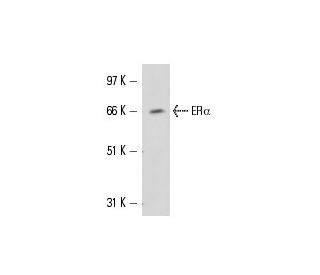

MCF7 nuclear extract: sc-2149
- supplied in four vials, each containing 250 µg nuclear extract in 50 µl buffer
- provided in 20 mM HEPES (pH 7.9), 20% v/v glycerol, 0.1 M KCI, 0.2 mM EDTA, 0.5 mM PMSF and 0.5 mM DTT
- human nuclear extract; mammary adenocarcinoma cells
- suitable for use in Gel Shift and Western Blotting assays
- Extracts should be stored at -70°C and repeated freezing and thawing should be avoided.
- prepared by the method of Dignam et al., (1983) Nucleic Acids Res. 11: 1475
QUICK LINKS
SEE ALSO...
MCF7 nuclear extract is a biochemical tool derived from the MCF7 cell line, extensively utilized in research to study the nuclear processes of breast epithelial cells. This extract is rich in nuclear proteins, including various transcription factors, RNA polymers, and DNA fragments, making it an invaluable resource for examining gene expression and regulatory mechanisms at the nuclear level. The MCF7 nuclear extract is commonly used in applications such as chromatin immunoprecipitation (ChIP) assays to investigate protein-DNA interactions, particularly those involving estrogen receptor signaling pathways. It is also employed in electrophoretic mobility shift assays (EMSA) to study the binding affinity and specificity of nuclear proteins to DNA sequences. These applications contribute to a deeper understanding of the transcriptional regulation in breast epithelial cells, focusing on how cellular processes are governed at the genetic level. The utility of MCF7 nuclear extract in basic biological research is underscored by its role in elucidating the networks of nuclear signaling that influence cell cycle regulation, proliferation, and gene expression. Verification of the MCF7 cell line's origin ensures the extract's reliability and relevance in scientific experiments.
MCF7 nuclear extract References:
- BRCA1 transactivates the cyclin-dependent kinase inhibitor p27(Kip1). | Williamson, EA., et al. 2002. Oncogene. 21: 3199-206. PMID: 12082635
- Functional promoter upstream p53 regulatory sequence of IGFBP3 that is silenced by tumor specific methylation. | Hanafusa, T., et al. 2005. BMC Cancer. 5: 9. PMID: 15661074
- Expression of ZER6 in ERalpha-positive breast cancer. | Stabach, PR., et al. 2005. J Surg Res. 126: 86-91; discussion 1-2. PMID: 15916980
- TSP50 encodes a testis-specific protease and is negatively regulated by p53. | Xu, H., et al. 2007. Cancer Res. 67: 1239-45. PMID: 17283160
- Evaluation of data-dependent versus targeted shotgun proteomic approaches for monitoring transcription factor expression in breast cancer. | Sandhu, C., et al. 2008. J Proteome Res. 7: 1529-41. PMID: 18311902
- cAMP responsive element binding protein-1 is a transcription factor of lysosomal-associated protein transmembrane-4 Beta in human breast cancer cells. | Zhang, M., et al. 2013. PLoS One. 8: e57520. PMID: 23469012
- Estrogen receptor protein content is different in abdominal than gluteal subcutaneous adipose tissue of overweight-to-obese premenopausal women. | Gavin, KM., et al. 2013. Metabolism. 62: 1180-8. PMID: 23557590
- CC-115, a dual inhibitor of mTOR kinase and DNA-PK, blocks DNA damage repair pathways and selectively inhibits ATM-deficient cell growth in vitro. | Tsuji, T., et al. 2017. Oncotarget. 8: 74688-74702. PMID: 29088817
- Involvement of Jun and Fos proteins in regulating transcriptional activation of the human pi class glutathione S-transferase gene in multidrug-resistant MCF7 breast cancer cells. | Moffat, GJ., et al. 1994. J Biol Chem. 269: 16397-402. PMID: 8206948
- Functional characterization of the transcription silencer element located within the human Pi class glutathione S-transferase promoter. | Moffat, GJ., et al. 1996. J Biol Chem. 271: 20740-7. PMID: 8702826
- Identification of a specific DNA region required for enhanced transcription of HER2/neu in the MDA-MB453 breast cancer cell line. | Miller, SJ., et al. 1996. DNA Cell Biol. 15: 749-57. PMID: 8836033
- Identification of ERF-1 as a member of the AP2 transcription factor family. | McPherson, LA., et al. 1997. Proc Natl Acad Sci U S A. 94: 4342-7. PMID: 9113991
- Pi-class glutathione S-transferase: regulation and function. | Henderson, CJ., et al. 1998. Chem Biol Interact. 111-112: 69-82. PMID: 9679544
Ordering Information
| Product Name | Catalog # | UNIT | Price | Qty | FAVORITES | |
MCF7 nuclear extract | sc-2149 | 250 µg/0.05 ml | $160.00 |
